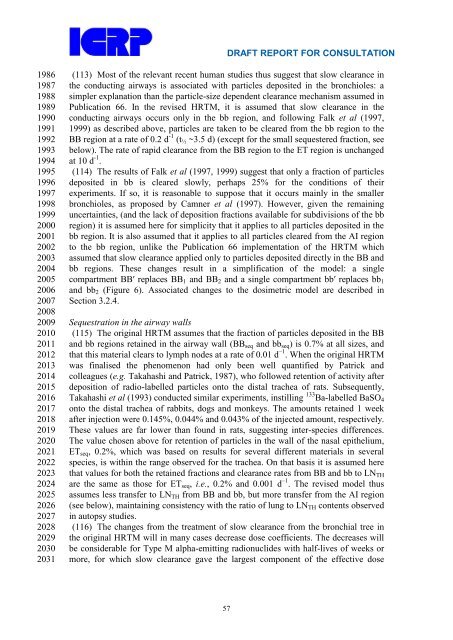Occupational Intakes of Radionuclides Part 1 - ICRP
Occupational Intakes of Radionuclides Part 1 - ICRP
Occupational Intakes of Radionuclides Part 1 - ICRP
You also want an ePaper? Increase the reach of your titles
YUMPU automatically turns print PDFs into web optimized ePapers that Google loves.
1986<br />
1987<br />
1988<br />
1989<br />
1990<br />
1991<br />
1992<br />
1993<br />
1994<br />
1995<br />
1996<br />
1997<br />
1998<br />
1999<br />
2000<br />
2001<br />
2002<br />
2003<br />
2004<br />
2005<br />
2006<br />
2007<br />
2008<br />
2009<br />
2010<br />
2011<br />
2012<br />
2013<br />
2014<br />
2015<br />
2016<br />
2017<br />
2018<br />
2019<br />
2020<br />
2021<br />
2022<br />
2023<br />
2024<br />
2025<br />
2026<br />
2027<br />
2028<br />
2029<br />
2030<br />
2031<br />
DRAFT REPORT FOR CONSULTATION<br />
(113) Most <strong>of</strong> the relevant recent human studies thus suggest that slow clearance in<br />
the conducting airways is associated with particles deposited in the bronchioles: a<br />
simpler explanation than the particle-size dependent clearance mechanism assumed in<br />
Publication 66. In the revised HRTM, it is assumed that slow clearance in the<br />
conducting airways occurs only in the bb region, and following Falk et al (1997,<br />
1999) as described above, particles are taken to be cleared from the bb region to the<br />
BB region at a rate <strong>of</strong> 0.2 d -1 (t½ ~3.5 d) (except for the small sequestered fraction, see<br />
below). The rate <strong>of</strong> rapid clearance from the BB region to the ET region is unchanged<br />
at 10 d -1 .<br />
(114) The results <strong>of</strong> Falk et al (1997, 1999) suggest that only a fraction <strong>of</strong> particles<br />
deposited in bb is cleared slowly, perhaps 25% for the conditions <strong>of</strong> their<br />
experiments. If so, it is reasonable to suppose that it occurs mainly in the smaller<br />
bronchioles, as proposed by Camner et al (1997). However, given the remaining<br />
uncertainties, (and the lack <strong>of</strong> deposition fractions available for subdivisions <strong>of</strong> the bb<br />
region) it is assumed here for simplicity that it applies to all particles deposited in the<br />
bb region. It is also assumed that it applies to all particles cleared from the AI region<br />
to the bb region, unlike the Publication 66 implementation <strong>of</strong> the HRTM which<br />
assumed that slow clearance applied only to particles deposited directly in the BB and<br />
bb regions. These changes result in a simplification <strong>of</strong> the model: a single<br />
compartment BB′ replaces BB1 and BB2 and a single compartment bb′ replaces bb1<br />
and bb2 (Figure 6). Associated changes to the dosimetric model are described in<br />
Section 3.2.4.<br />
Sequestration in the airway walls<br />
(115) The original HRTM assumes that the fraction <strong>of</strong> particles deposited in the BB<br />
and bb regions retained in the airway wall (BBseq and bbseq) is 0.7% at all sizes, and<br />
that this material clears to lymph nodes at a rate <strong>of</strong> 0.01 d –1 . When the original HRTM<br />
was finalised the phenomenon had only been well quantified by Patrick and<br />
colleagues (e.g. Takahashi and Patrick, 1987), who followed retention <strong>of</strong> activity after<br />
deposition <strong>of</strong> radio-labelled particles onto the distal trachea <strong>of</strong> rats. Subsequently,<br />
Takahashi et al (1993) conducted similar experiments, instilling 133 Ba-labelled BaSO4<br />
onto the distal trachea <strong>of</strong> rabbits, dogs and monkeys. The amounts retained 1 week<br />
after injection were 0.145%, 0.044% and 0.043% <strong>of</strong> the injected amount, respectively.<br />
These values are far lower than found in rats, suggesting inter-species differences.<br />
The value chosen above for retention <strong>of</strong> particles in the wall <strong>of</strong> the nasal epithelium,<br />
ETseq, 0.2%, which was based on results for several different materials in several<br />
species, is within the range observed for the trachea. On that basis it is assumed here<br />
that values for both the retained fractions and clearance rates from BB and bb to LNTH<br />
are the same as those for ETseq, i.e., 0.2% and 0.001 d –1 . The revised model thus<br />
assumes less transfer to LNTH from BB and bb, but more transfer from the AI region<br />
(see below), maintaining consistency with the ratio <strong>of</strong> lung to LNTH contents observed<br />
in autopsy studies.<br />
(116) The changes from the treatment <strong>of</strong> slow clearance from the bronchial tree in<br />
the original HRTM will in many cases decrease dose coefficients. The decreases will<br />
be considerable for Type M alpha-emitting radionuclides with half-lives <strong>of</strong> weeks or<br />
more, for which slow clearance gave the largest component <strong>of</strong> the effective dose<br />
57

















